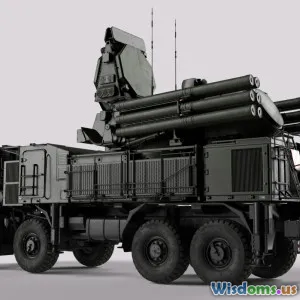
Five CuttingEdge Laser Technologies for Shooting Down Hypersonic Missiles
9 min read Explore five revolutionary laser technologies designed to intercept and neutralize hypersonic missile threats with precision and speed. (0 Reviews)
Five Cutting-Edge Laser Technologies for Shooting Down Hypersonic Missiles
Introduction
The rapid advancement of hypersonic missile technology is reshaping the landscape of modern warfare and defense systems. These weapons, capable of exceeding Mach 5 speeds, present unique challenges due to their incredible velocity, maneuverability, and low flight trajectories. Traditional missile defense methods, such as interceptor missiles and radar tracking, often struggle to respond in time, making innovative solutions a critical priority for global security. Among the most promising of these solutions are laser-based technologies, which offer near-instantaneous response times, precision targeting, and scalability.
This article explores five of the most advanced laser technologies designed specifically to detect, track, and neutralize hypersonic missile threats, highlighting their current development stages, operational strengths, and future implications.
1. High-Energy Fiber Laser Systems (HEFLS)
Fiber lasers represent a breakthrough in directed-energy weapons due to their efficiency, beam quality, and scalability. High-energy fiber lasers (HEFLS) employ fiber optic technology to produce a concentrated beam capable of causing structural damage to target objects.
How It Works
HEFLS generate high power densities over sustained periods, allowing continuous energy delivery onto a hypersonic missile's surface. The intense heat rapidly weakens the missile’s skin or critical components, resulting in structural failure or malfunction.
Real-World Progress
The United States’ Solid-State Laser–Technology Maturation (SSL-TM) program has successfully tested fiber lasers capable of delivering 300 kW-class beams onboard naval platforms. The adaptability and modular nature of fiber lasers also allow integration into existing defense infrastructures.
Advantages
- Lower heat dissipation needs compared to traditional lasers
- Ability to maintain beam quality over longer distances
- Compact and scalable design optimal for mobile and maritime defense
2. Chemical Oxygen Iodine Laser (COIL)
As one of the earliest high-power chemical lasers developed, COIL technology remains a gold standard in high-energy beam applications and continues evolving in the context of missile defense.
Technology Insight
COIL functions by producing excited iodine atoms chemically, which in turn produce infrared laser emissions near 1.315 micrometers. Its chemical pumping mechanism bypasses the electrical energy conversion bottleneck seen in solid-state lasers, enabling extremely high energy output.
Status and Efforts
The U.S. Air Force and Israel have advanced adaptive COIL platforms, with experiments demonstrating successful engagement of high-speed airborne targets. The Defense Advanced Research Projects Agency (DARPA)'s Chemical Laser Weapon System (CHELWS) project also aims to perfect compact chemical laser weaponry.
Benefits
- Very high output power capable of disabling missiles instantly
- Effective at medium to long engagement ranges
- Proven track record in high-energy directed-energy weapons
3. Thin-Disk Laser Technology
Thin-disk lasers represent a significant innovation in boosting power levels without compromising beam quality. Their unique design mitigates thermal distortions that plague high-power lasers.
Operational Principle
By using a thin gain medium mounted on a heat sink, these lasers maintain stable output even as power scales up. This stability lets them sustain high beam quality critical for accurate missile targeting.
Rising Applications
European defense contractors, such as MBDA and the European Defence Agency partnership, are exploring thin-disk lasers combined with adaptive optics to build hypersonic missile countermeasures, emphasizing reliability in variable operational conditions.
Key Features
- Scalability for multi-kilowatt to megawatt-class power
- Compact and efficient cooling mechanisms
- High resilience to environmental conditions
4. Free Electron Lasers (FELs)
FELs present a futuristic approach, offering tunable wavelengths and extraordinary power outputs by accelerating electrons in magnetic undulators.
Mechanism Details
Unlike traditional lasers relying on atomic transitions, FELs use high-velocity electron beams passing through a magnetic array to produce coherent electromagnetic radiation covering a wide spectral range. This tunability allows the system to adapt the laser frequency to optimal absorption characteristics of missile materials.
Research and Prototypes
The U.S. Navy's Laser Megawatt Facility in Dahlgren experimented with FELs for airborne threat neutralization. Although the technology is complex and costly, its ability to rapidly switch wavelengths offers unique advantages against diverse hypersonic missile designs.
Distinguishing Advantages
- Adjustable wavelength to penetrate protective missile coatings
- Potential for extreme power outputs exceeding megawatts
- Flexibility to counter evolving missile technologies
5. Solid-State Laser with Adaptive Optics
Integrating adaptive optics into solid-state laser systems pushes their capabilities further by correcting atmospheric distortion that can degrade laser accuracy.
Technology Overview
Adaptive optics utilize deformable mirrors and wavefront sensors to compensate for turbulence and environmental effects encountered when shooting lasers through the atmosphere. This dynamic correction preserves the beam’s focus at long distances.
Impact on Hypersonic Defense
As hypersonic missiles fly at high speeds and low altitudes, lasers must maintain precision under challenging viewing conditions. Adaptive optics-enhanced solid-state lasers, such as those developed by Lockheed Martin’s ATHENA system, have demonstrated effective missile engagements at tens of kilometers.
Operational Benefits
- Superior beam focus leads to reduced engagement time
- Enhanced precision minimizes collateral damage
- Can be integrated on airborne, sea, or ground platforms
Conclusion
Hypersonic missiles are among the most demanding defense challenges due to their unparalleled speed and evasive capabilities. Laser technologies, with their near-instantaneous engagement and precise energy delivery, are at the forefront of revolutionizing missile defense.
Each of the five cutting-edge laser systems—high-energy fiber lasers, chemical oxygen iodine lasers, thin-disk lasers, free electron lasers, and adaptive optics-enhanced solid-state lasers—offers distinct advantages. Together, they form a multi-layered defense approach, enhancing detection, tracking, and destruction of hypersonic threats.
Ongoing advancements, supported by extensive government and private sector investments, promise that laser weapons will become pivotal in securing skies and safeguarding nations. As the race between offensive hypersonic capabilities and defensive countermeasures intensifies, laser technology stands out as a beacon of hope firmly rooted in scientific innovation and operational pragmatism.
"The future of missile defense hinges on our ability to harness light itself as a weapon—a challenge that technical innovation steadily conquers." — Dr. Emily Sanchez, Defense Technology Analyst
References:
- U.S. Department of Defense. (2023). Directed Energy Weapons Programs Overview.
- DARPA. (2022). Progress in Chemical Laser Weapon Systems.
- Lockheed Martin ATHENA Tests (2021).
- European Defence Agency Reports on Laser Weapon Development (2023).
- Naval Surface Warfare Center: Free Electron Laser Research Summary (2022).
Rate the Post
User Reviews
Popular Posts



















